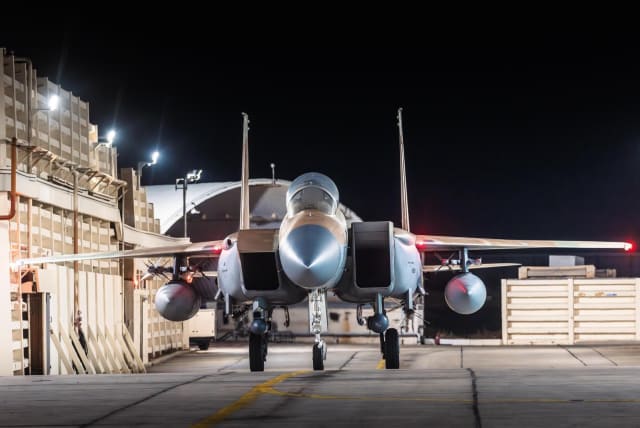Article
Busting Beirut’s bunkers: Israel’s history with bunker-buster bombs – analysis

In 1981, Israel destroyed Iraq’s nuclear reactor, leading Iran, Hamas, and Hezbollah to build underground facilities, countered by bunker-busting bombs like the GBU-28.
In the IDF’s attack on Beirut on Friday, which killed Hezbollah chief Sayyed Hassan Nasrallah in addition to several other Hezbollah commanders, the Israeli military used “bunker-buster” bombs, which have a long history.

The nuclear reactor in Iraq was destroyed in 1981 by eight Israel Air Force pilots using regular, simple “Iron” bombs. One of the lessons learned by Iran when they began their military nuclear program was to build underground production facilities for their most sensitive components, which are much harder to destroy, protected by tons of concrete and natural rock.
Hamas and Hezbollah also learned this lesson and started constructing tunnels and underground command bunkers.
This prompted the IAF’s interest in the American GBU-28 bomb, which was introduced at the end of the Gulf War in 1991 to allow the US to target bunkers where they hoped to kill Saddam Hussein. Saddam was eventually found hiding in a hole, but the American arsenal expanded. The US never officially reported that it sold the bomb to Israel to avoid being accused of arming it for an attack on Iran.
However, a Walla report noted that according to WikiLeaks documents, the IAF received such bombs as early as the previous decade, and the US only reported selling Israel a smaller version, the GBU-39. The IAF is also equipped with bunker-busting bombs made by Elbit, known as MPR-500 in their export version.
So what makes bunker-busting bombs special, such as those used by the IAF in the past day to attack Hezbollah’s headquarters in Beirut and nearby missile launch sites?
The GBU-28, for example, has been proven in tests to penetrate up to about six meters of concrete. It achieves this through a strong structure that maintains its shape and does not get crushed when it strikes the roof of the target facility at high speed, beginning its descent downward.

N AND his copilot prepare their aircraft for takeoff. N was an active member of Israel’s defense systems that were activated Saturday night when Iran targeted Israel with hundreds of drones and missiles. (credit: IDF SPOKESPERSON’S UNIT)
The bomb weighs 2.3 tons and has thicker steel than many other bombs, giving it increased strength. On the other hand, its warhead is half the size of a typical bomb of similar weight because it doesn’t require a powerful explosion to destroy its lower levels once it penetrates the underground structure.
Bombs to penetrate underground targets
Often, these types of bombs use depleted uranium in their casing, similar to certain shells, which enhances their strength. While this does not make them nuclear weapons, it does disperse radioactive contamination at the impact site, which can be felt in an area of several meters, at low levels.
Another component is a smart fuse programmed to detonate the warhead based on speed calculations, either when the bomb has completed its motion and penetrated its maximum depth or during its descent if the goal is to destroy a specific floor in a multi-story underground structure.
Although the impact speed can aid penetration, these bombs are not equipped with rocket engines and only gain speed after gliding toward the target, following release from the fighter jet. Since bunkers do not move, accurately hitting them is not a problem; however, it is crucial to release the bomb from the aircraft with precise speed and altitude data so it strikes the target at the right point, angle, and speed to maximize its penetration capability.
Multiple bombs can strike in succession to penetrate deeper than a single bomb could, but this also requires precise work from the pilots and coordination between the aircraft during bomb release. These will be guided by a laser or satellite connected to a kit like Boeing’s JDAM.
Due to its size and weight, the GBU-28 can only be carried by the IAF’s F-15 jets, particularly the modified Ra’am models suited for strike missions. The US Air Force also has a significantly larger bomb, weighing 10 tons and called the MOAB (Mother Of All Bombs), developed to demonstrate American capability to penetrate Iran’s well-buried nuclear facilities in Fordow. Due to its dimensions, it is only carried by the stealthy B-2 bombers.
Bunker-busting bombs like the American GBU-39 and the Israeli MPR-500 can also be carried by F-16s. However, due to their smaller size, their penetration capability is lower—about 4 meters of concrete—and they have been used against Hamas tunnels and bunkers in the Iron Swords War. They are also cheaper to acquire than the GBU-28.
These bombs can be transported in the cargo hold of Hercules aircraft, which releases them during a gentle ascent. They glide down through the open rear ramp like a standard cargo drop, deploying a parachute for stabilization before detaching and gaining speed on the way to impact.
The Americans have not sold this bomb to any foreign country, and although Israel has Hercules planes, the low likelihood of a transport aircraft safely reaching Iran and returning after such a bombing has not led to any attempts to request it from the US Department of Defense. The IAF previously used Nord transport aircraft for attacks on bridges in Egypt during the War of Attrition, and only by luck and the composure of the pilots did they return safely to their base.
























